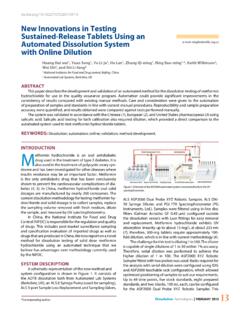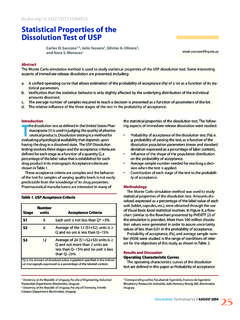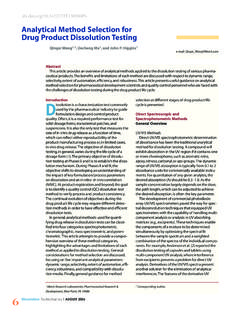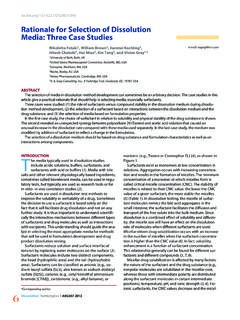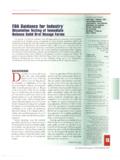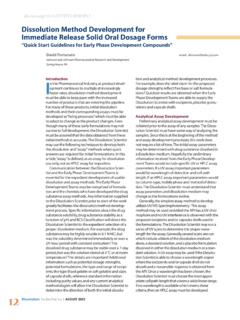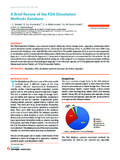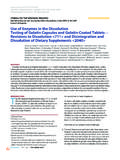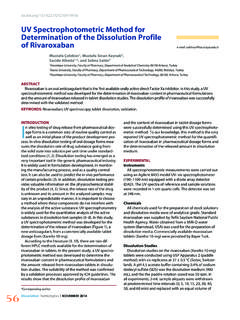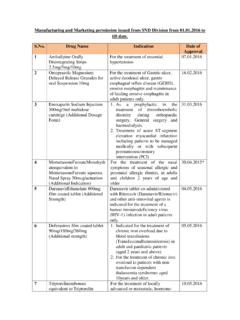Transcription of Introduction - Dissolution Tech
1 Arnold H. Beckett, Tlnh T. Quach Improved Hydrodynamics for USP Apparatus 2 Biovail Corporation /l1te171fltionol, Toronto, Conadn Glenn s. Kurs VnnKellndltstries, /11( . Edison, NJ Abstract In spite of irs growing importance in tbe modern Dissolution InboraUJry, USP Apparatus 2 bas been plagued by many problems of reproducibility and accuracy wbicb lend to wasted time using calibrators even wiJe1J tbf1'e is nothing wrong with the calibrators or the instruments. Tbe primary source of variability bas been found to be ;71 the hydrodynamics of the conv emional cylind11cnl ( USP hemispherical) vessel especially untie.)
2 ,. the rotating paddle. A new vessel, called the PEAK vessel. has been df!Veloped whicb lends to better reproducibility and accelerated Dissolution rates at c()1ltpnrable paddle speeds. The PFAK vessel eliminates the need for cumbersome deaeration, (7)er-C(flnts the problems caused by the differences in characteristics of currently manufactured hand made vesseis, and a/lows for the use of sampling probes of dijfm:n' sizes and characteristics in different locations in the vessels. Introduction USP Apparatus 2 (paddle method) has become the workhorse instrument in the mod-em Dissolution laboratory. It is expected to provide rugged and reproducible results, on which decisions about product quality, bioavaiI3bi~ty, bioequivalence etc.)
3 Are based. However, in practice, the apparatus tends to be extremely sensitive to outside and inside variables, ,vith large changes in Dissolution profiles resulting from small changes in fac-tors such as paddle rotational speed, vibration, deaeration and insertion of sampling probes (1,2). This can render results meaningless or impossible to interpret and thus constmle enonnous amounts of precious analyst rime in investigating, correcting and re-va~dating the systems. It is largely for this reason that Dissolution testing is usually regarded as nothing more than a mandated "service tool" of questionable perfonnance used only to satis/)' regulatory requirements, rather than a powerful predictive tool for pharmaceutical research and development (3).
4 Hydrodynamic Problems Recent Dissolution studies by Wang and Coffin (4) have shown that the commonly used rotation speed of 50 rpm for tablet Dissolution can c reate cones of insoluble materials SIDE VIEW on the bottom of the vessel. This cone is the result of the radial fluid flow present in USP cylindrical most of the material which accu-mulates inside is effectively shielded from the bulk of the moving medium In the vessel. Therefore, any external factor which alters the cone, such as speed changes, vessels. Invisible to the analyst'S eye unless solids are Fig"re J. US? Vessel vibration, type and duration of deaeration or inserted sample probe, can have a large influence on the Dissolution present, this unstirred region is clearly visible when disintegrat-ing tablets are used, as evi-denced by a large and clearly defined cone of disintegrated material (Figure 1).
5 Much of the variability in Dissolution rates observed using Apparatus 2 is attributable to this cone, since outcome. A lso, the invisible liquid cone around non-disinte-grating tablets is affected similarly. The rate controlling step of drug release from the product to the bulk Dissolution medium often becomes the rate of release from the cone rather than the rate of release under II Disso/1ltiollTechnologiesIMA Y 1996 Hydrodynamics .. cont. sink conditions, even t hough t here is e nough volume of liquid in the Dissolution vessel to theo-retically provide the desired condition. The Solution A new vessel has been developed which elimi-nates the unstirred cone, and as a result, the vari-ability concomitant with it.
6 T he new PEAK (5) vessel has a cone molded into the bottom using an appropriate tool to control its d imensions accurately (Figure 2). T he glass cone effectively displaces the unstirred cone, forcing the material tested into the region of appropriate hydrody-namics, where all surfaces of th e produc t are constantly and unifofmJy exposed to the moving medium. Experimental resu lts show that this simple modification e limjnates the above stated problems as s hown in rile following examples. Stirring Speed and Deaeration C hanges in stirring speed and the air bubbles which tend to form in nondeaerated media c hange the flow c haracteristics of the media in conventional cylindrical vessels and accele rate dis pe rsion of the cone, leading to erratic increas-es in Dissolution rates compared to thoroughly deaerated media (I).
7 Because the cone is already effectively well d ispersed in PEAK vessels, Dissolution rates are not influenced by the presence of air bubbles, ., Dissolution rates are the same, whether or not the medium is deaerated. Figures 3, 4, & 5 show the results of trial te sts in PEAK and conventional vessels using both t he USP salicylic acid and predniso ne calibrators as well as the NCDA#2 10 mg prednisone tablets . Influence of Deaeration USP prednisone Calibrator 50 mg tablets @50rpm Tablat (%) I . P .. k o USP .. , "" Lm' '" , j ~ 0 NO 0 NO 0 NO 0 NO 0 " Oeaerated NO .. Nondeaeraled DlNOIutoon bo~ .. ill !
8 LOCI mw oI .. t kif JO m .. tIN"Ig ~ ""tJan N. negligible KlI!utrq on both P .. k and USP .. Figm'e 4 Disso/1ttio7lTechn%giesIMA Y 1996 i i5 " .,~-SIDE VIEW Figure 2. PEAK Vessel Influence of Deaeratlon FDA prednisone NCDM2 10 mg tablets @50rpm o NO 0 NO o NO 0 NO o .. Oeaerated NO .. Nondeaerated DIUCJkAIorIIt~ ~ on 500 m .. 01 Wilit kif :10 minoA" .. peddle o.. I1ion!IZtIi!U!tII diuoIuIIon fabo in USP .. bill NI DlQIigibIt """'-nEt on P .. k .. Figure 3 Influence of Deaeration USP Salicydic AcId Calibrator 300 mg tablets C 50 rpm '"' Ind ividual Tablet (%) I .P .. k OUSP Lob' "'" Lob' L>b , 20 ~ I~, I ~~~~ , ~~~~~ , 0 o NO o NO o NO o NO 0 " Oeaerated NO IE Nondeaeraled Oiuolu:lQn te~ W'f' in 900 mil 01 0 0' M ~t.
9 BttI., p/"I1 of for 30 m .. using ~Ie Figure 5 Influence of Speed FDA prednisone NCDM2 10 mg tablets 50 75 100 50 75 100 Speed (rpm) ~ 1 .. 1, were perfooned In 500 roll 01 dH'ra!M' ~1"'1or 30 minulH Ullog _. PNk .. __ 11M biIabIt d~ .. 1 UIs th8n usp .. MII C~. oIlQtMon Ipeed 50. 100 rpm 1 IIo .. IlI!: : on diuoUion re" ~ PNk .. tu 11M ""''''. muKlQ ,.;ng USP .. MII. Figure 6 Conventional vessels exhjbit marked differences in results between deaerated and nondeaerated media whereas PEAK vessels do not. Using both PEAK and conventional vessels at speeds of 50,75 and 100 rpm, the Dissolution rates obtained in the former are at least twice that of the latter, are more reproducible, and differ little with changes in paddle rotational speed (Figures 6 & 7).
10 In contrast, Dissolution rates in conventional vessels were extremely sensitive to paddle Influence of Speed USP Salicydlc Add Calibrator 300 mg tablets 50 75 100 50 75 100 Speed (rpm) DiUoIution lnll wire pe/fo(med In iOO roll pf O"'[I"d 0 05 M pholplllol, butt .. pH 7. for 30 mlnuC .. UIing ptlddle. Peek ..,Ie g;..lIIIaIlIrdisdAion USP WlSMI$; II IIYH d"ferenl peddle fObltion 1 IpOte<II" Figm-e 7 rotational speed_ By inference, these data indicate that other factors such as internal or external vibration will have minimal effects on Dissolution rates in PEAK vessels and to date no problems from vibration have been observed.)]
